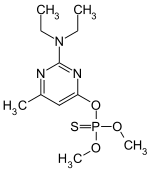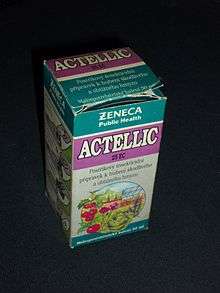Pirimiphos-methyl
Pirimiphos-methyl, marketed as Actellic,[1][2][3][4] and Sybol is a phosphorothioate used as an insecticide. It was originally developed by Imperial Chemical Industries Ltd., now Syngenta, in 1967.[5]
 | |
| Names | |
|---|---|
| IUPAC name
O-[2-(Diethylamino)-6-methylpyrimidin-4-yl] O,O-dimethyl phosphorothioate | |
| Other names
Pirimifos-methyl | |
| Identifiers | |
CAS Number |
|
3D model (JSmol) |
|
| ChEBI | |
| ChemSpider | |
| ECHA InfoCard | 100.045.011 |
| KEGG | |
PubChem CID |
|
CompTox Dashboard (EPA) |
|
InChI
| |
SMILES
| |
| Properties | |
Chemical formula |
C11H20N3O3PS |
| Molar mass | 305.33 g·mol−1 |
| Appearance | Straw-colored liquid |
| Density | 1.147 g/mL (30 °C) |
| Melting point | 15 to 18 °C (59 to 64 °F; 288 to 291 K) |
| Boiling point | decomposes before boiling |
Solubility in water |
5.0 mg/L (30 °C) |
| Hazards | |
EU classification (DSD) (outdated) |
Harmful (Xn), Dangerous for the environment(N) |
| R-phrases (outdated) | R22, R50/53 |
| S-phrases (outdated) | (S2), S60, S61 |
| Flash point | 46 °C (115 °F; 319 K) |
Except where otherwise noted, data are given for materials in their standard state (at 25 °C [77 °F], 100 kPa). | |
| Infobox references | |

Organophosphate insecticide with pirimiphos-methyl (no longer in production)
This is one of several compounds used for vector control of Triatoma. These insects are implicated in the transmission of Chagas disease in the Americas.[6] Pirimiphos-methyl can be applied as an interior surface paint additive, in order to achieve a residual pesticide effect.
Pyrimiphos-ethyl is a related insecticide in which the methyl groups are replaced with ethyl groups.
References
- "Actellic50EC". www3.syngenta.com. Retrieved 2015-11-11.
- "Common Chemistry - Substance Details - 29232-93-7 : Phosphorothioic acid, O-[2-(diethylamino)-6-methyl-4-pyrimidinyl]O,O-dimethyl ester". www.commonchemistry.org. Retrieved 2015-11-11.
- "Actellic 50 EC". www3.syngenta.com. Retrieved 2015-11-11.
- "ACTELLIC 50 EC: FIŞA CU DATE DE SECURITATE" (PDF) (in Romanian). Syngenta. 2013. Archived from the original (PDF) on 2016-09-10. Retrieved 2015-11-11.
- "syngenta: Celebrating 75 years of scientific excellence at Jealott's Hill International Research Centre" (PDF). Archived from the original (PDF) on October 11, 2007. Retrieved June 26, 2012.
- CHAPTER 3: Triatomine bugs, Vectors of Chagas disease, World Health Organization
This article is issued from
Wikipedia.
The text is licensed under Creative
Commons - Attribution - Sharealike.
Additional terms may apply for the media files.